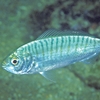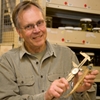General Description
Head slightly compressed; snout short, blunt; mouth oblique, terminal, reaching to below middle of eye; eyes large, close together on top of head; tail weakly pointed to slightly rounded; pectoral fins large, weakly pointed to slightly rounded. Greyish-brown with black spots on head, about 8 irregular bands on sides; horizontal stripe on side of head from eye across top of gill cover; usually a vertical dark bar below eye. To 11 cm.
Biology
These gobies seek shelter in burrows.
Habitat
Seagrass beds or mangrove creeks in bays, estuaries and coastal lagoons, in depths of 0-10 m.
Seagrass meadows
Distribution guide
Eastern Australia, including central and eastern Victoria.
Species Group
Depth
Water Column
Max Size
11 cm
Commercial Species
No
Global Dispersal
Recorded in Australia
Identify
Conservation Status
- DSE Advisory List : Not listed
- EPBC Act 1999 : Not listed
- IUCN Red List : Not listed





